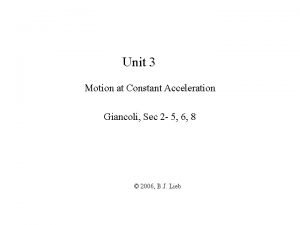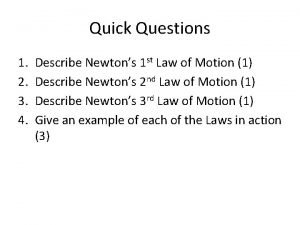The 100 metre race THE WORLDS GREATEST SPRINTER









- Slides: 9

The 100 metre race THE WORLD’S GREATEST SPRINTER, USAIN BOLT, AGAINST THE WORLD’S FASTEST SPRINT CYCLIST, RENÉ ENDERS. WHO WINS?

Usain Bolt vs Rene Enders over 100 metres: who wins the race? THE RUNNER: USAIN BOLT Men’s sprint 100 m World Record is 9. 58 seconds http: //news. bbc. co. uk/sport 1/hi/athletics/82 04381. stm Alternative: http: //www. youtube. com/watch? v=By 1 JQFxf LMM THE CYCLIST: RENÉ ENDERS The men’s cycling world record for a 250 m lap from a standing start is 16. 984 seconds, by René Enders of Germany. https: //www. youtube. com/watch? v=6 YIn. Uq 6 u. Mw. U (This video is of the German team, which includes Enders. A video of the world record ride is not available).

Explore some ways to solve the problem. How could you use this information to decide who will win in a 100 metre race from a standing start? What calculations could you make? What diagrams could you draw? Usain Bolt’s 100 metre World Record is 9. 58 seconds René Enders’ 250 metre (one lap) cycling World Record is 16. 984 seconds, from a standing start.

Explore some ways to solve the problem. What assumptions are you making? What are the limitations of the data we have? What further information do you need? Usain Bolt’s 100 metre World Record is 9. 58 seconds René Enders’ 250 metre (one lap) cycling World Record is 16. 984 seconds, from a standing start.

The 100 metre race: Evaluating solutions LOOK AT THE FOLLOWING IDEAS. IN WHAT WAYS ARE THEY USEFUL? WHAT ASSUMPTIONS HAVE BEEN MADE? HOW COULD THESE SOLUTIONS BE IMPROVED?

The Calculation What assumptions have been made in this calculation? Are these assumptions reasonable? What further information do you need to make better calculations? If René Enders completed 250 m in 16. 984 seconds, then to cover 100 m he would take (16. 984 ÷ 250) x 100 seconds. This equals 6. 7936 seconds

The Graph How would you read the graph to tell you who would win the race? What assumptions have been made in drawing this graph? Are these the same assumptions as in the calculation? How can it be improved? Time (seconds) Graph to show the progress of Bolt’s and Enders' world record sprints 18 16 14 12 10 8 6 4 2 0 0 50 100 150 Distance (m) Enders Bolt 200 250

. Distance run (metres) 10 20 30 40 50 60 70 80 90 100 Time (seconds) 1. 89 2. 88 3. 78 4. 64 5. 47 6. 29 7. 10 7. 92 8. 75 9. 58 Split times These are estimated times at each 10 m stage for Usain Bolt’s world record 100 m run in Berlin on the 16 th August 2009.

Qualification standards for cyclists The standards are those published by the Australian National Track Cycle Team for their selection process. These are the standards that a male cyclist has to achieve to be considered for the team for the World Championships and the Olympic Games. Men’s Standing 250 m 17. 40 sec Last half lap split time of 6. 75 sec Additional information: A cyclist reaches top speed in this event at about 90 metres.
















